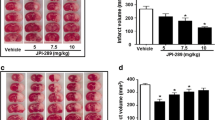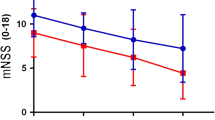Abstract
Cerebral ischemic injury involves a variety of cellular and molecular events. Signal transducers and activators of transcription-1 (STAT-1) activation is associated with neuronal cell death and contributes to ischemic injury. The effects of fludarabine, a specific inhibitor of STAT1 protein, on cerebral ischemic/reperfusion (I/R) injury were studied in a rat model. Rats subjected to I/R injury were either treated with intra-cerebroventricular injection of fludarabine (5,000 μM, 10 μl) or saline 20 min before middle cerebral artery occlusion (MCAO). MR examinations including T2-weighted imaging (T2WI), diffusion-weighted imaging (DWI), and perfusion-weighted imaging (PWI) were performed after I/R period. Then rat brains were sectioned for triphenyltetrazolium chloride (TTC) stains, analyzed by Western blot and TUNEL staining of apoptosis. It was found that fludarabine treatment decreased the infarct volume of the cerebrum and the number of apoptotic neural cells in the ischemic brain. Compared to saline-treated group, the apparent diffusion coefficient (ADC) and cerebral blood volume (CBV) in the ischemic region were greater, and the mean transit time (MTT) was shortened in the fludarabine-treated group. Moreover, fludarabine inhibited the expression level of phosphorylated STAT1 (P-STAT1) in neural cells after I/R injury, whereas the expression of phosphorylated STAT3 (P-STAT3) was increased. Therefore, we concluded that fludarabine administrated in early stage of cerebral ischemia had neuroprotective effects, and the underlying mechanism could be mediated through inhibiting STAT1 phosphorylation and activating the cross regulation between STAT1 and STAT3 in neural cells.




Similar content being viewed by others
References
Baird AE, Warach S (1998) Magnetic resonance imaging of acute stroke. J Cereb Blood Flow Metab 18:583–609
Battle TE, Frank DA (2002) The role of STATs in apoptosis. Curr Mol Med 2:381–392
Cai F, Li CR, Wu JL et al (2006) Theaflavin ameliorates cerebral ischemia–reperfusion injury in rats through its anti-inflammatory effect and modulation of STAT-1. Mediators Inflamm 2006:30490
Chan KC, Khong PL, Lau HF, Cheung PT, Wu EX (2009) Late measures of microstructural alterations in severe neonatal hypoxic–ischemic encephalopathy by MR diffusion tensor imaging. Int J Dev Neurosci 27:607–615
De-Fraja C, Conti L, Magrassi L, Govoni S, Cattaneo E (1998) Members of the JAK/STAT proteins are expressed and regulated during development in the mammalian forebrain. J Neurosci Res 54:320–330
Dziennis S, Alkayed NJ (2008) Role of signal transducer and activator of transcription 3 in neuronal survival and regeneration. Rev Neurosci 19:341–361
Dziennis S, Jia T, Ronnekleiv OK, Hurn PD, Alkayed NJ (2007) Role of signal transducer and activator of transcription-3 in estradiol-mediated neuroprotection. J Neurosci 27:7268–7274
Frank DA, Mahajan S, Ritz J (1999) Fludarabine-induced immunosuppression is associated with inhibition of STAT1 signaling. Nat Med 5:444–447
Hossmann K-A, Hoehn-Berlage M (1995) Diffusion and perfusion MR imaging of cerebral ischemia. Cerebrovasc Brain Metab Rev 7:187–217
Hou YC, Liou KT, Chern CM et al (2010) Preventive effect of silymarin in cerebral ischemia–reperfusion-induced brain injury in rats possibly through impairing NF-κB and STAT-1 activation. Phytomedicine 17:963–973
Keating MJ, O’Brien S, Robertson LE et al (1993) New initiatives with fludarabine monophosphate in hematologic malignancies. Semin Oncol 20:13–20
Kim HS, Lee MS (2007) STAT1 as a key modulator of cell death. Cell Signal 19:454–465
Komine-Kobayashi M, Zhang N, Liu M et al (2006) Neuroprotective effect of recombinant human granulocyte colony-stimulating factor in transient focal ischemia of mice. J Cereb Blood Flow Metab 26:402–413
Longa EZ, Weinstein PR, Carlson S, Cummins R (1989) Reversible middle cerebral artery occlusion without craniectomy in rats. Stroke 20:84–91
Martinez-Lostao L, Briones J, Forné I et al (2005) Role of the STAT1 pathway in apoptosis induced by fludarabine and JAK kinase inhibitors in B-cell chronic lymphocytic leukemia. Leuk Lymphoma 46:435–442
Menegazzi M, Novelli M, Beffy P et al (2008) Protective effects of St. John’s wort extract and its component hyperforin against cytokine-induced cytotoxicity in a pancreatic beta-cell line. Int J Biochem Cell Biol 40:1509–1521
Moseley ME, Kucharczyk J, Mintorovitch J et al (1990) Diffusion-weighted MR imaging of acute stroke: correlation with T2-weighted and magnetic susceptibility-enhanced MR imaging in cats. AJNR Am J Neuroradiol 11:423–429
Mui AL (1999) The role of STATs in proliferation, differentiation, and apoptosis. Cell Mol Life Sci 55:1547–1558
Planas AM, Soriano MA, Berruezo M et al (1996) Induction of Stat3, a signal transducer and transcription factor, in reactive microglia following transient focal cerebral ischaemia. Eur J Neurosci 8:2612–2618
Shen Y, Devgan G, Darnell JE Jr, Bromberg JF (2001) Constitutively activated Stat3 protects fibroblasts from serum withdrawal and UV-induced apoptosis and antagonizes the proapoptotic effects of activated Stat1. Proc Natl Acad Sci U S A 98:1543–1548
Sorensen AG, Buonanno FS, Gonzalez RG et al (1996) Hyperacute stroke: evaluation with combined multisectiondiffusion-weighted and hemodynamically weighted echo-planar MR imaging. Radiology 199:391–401
Stephanou A, Latchman DS (2003) STAT-1: a novel regulator of apoptosis. Int J Exp Pathol 84:239–244
Stephanou A, Brar BK, Scarabelli TM et al (2000a) Ischemia-induced STAT-1 expression and activation play a critical role in cardiomyocyte apoptosis. J Biol Chem 275:10002–10008
Stephanou A, Brar BK, Knight RA, Latchman DS (2000b) Opposing actions of STAT-1 and STAT-3 on the Bcl-2 and Bcl-x promoters. Cell Death Differ 7:329–330
Stephanou A, Scarabelli TM, Brar BK et al (2001) Induction of apoptosis and Fas receptor/Fas ligand expression by ischemia/reperfusion in cardiac myocytes requires serine 727 of the STAT-1 transcription factor but not tyrosine 701. J Biol Chem 276:28340–28347
Stephanou A, Scarabelli TM, Townsend PA et al (2002) The carboxyl-terminal activation domain of the STAT-1 transcription factor enhances ischemia/reperfusion-induced apoptosis in cardiac myocytes. FASEB J 16:1841–1843
Swanson RA, Morton MT, Tsao-Wu G, Savalos RA, Davidson C, Sharp FR (1990) A semiautomated method for measuring brain infarct volume. J Cereb Blood Flow Metab 10:290–293
Tajima K, Takaishi H, Takito J et al (2010) Inhibition of STAT1 accelerates bone fracture healing. J Orthop Res 28:937–941
Takagi Y, Harada J, Chiarugi A, Moskowitz MA (2002) STAT1 is activated in neurous after ischemia and contributes to ischemic brain injury. J Cereb Blood Flow Metab 22:1311–1318
Torella D, Curcio A, Gasparri C et al (2007) Fludarabine prevents smooth muscle proliferation in vitro and neointimal hyperplasia in vivo through specific inhibition of STAT-1 activation. Am J Physiol Heart Circ Physiol 292:H2935–H2943
Townsend PA, Scarabelli TM, Pasini E et al (2004) Epigallocatechin-3-gallate inhibits STAT-1 activation and protects cardiac myocytes from ischemia/reperfusion-induced apoptosis. FASEB J 18:1621–1623
Warach S, Dashe JF, Edelman RR (1996) Clinical outcome in ischemic stroke predicted by early diffusion-weighted and perfusion magnetic resonance imaging: a preliminary analysis. J Cereb Blood Flow Metab 16:53–59
West DA, Valentim LM, Lythgoe MF et al (2004) MR image-guided investigation of regional signal transducers and activators of transcription-1 activation in a rat model of focal cerebral ischemia. Neuroscience 127:333–339
Author information
Authors and Affiliations
Corresponding author
Additional information
Xu and Jiang are co-first authors
Rights and permissions
About this article
Cite this article
Xu, Q., Jiang, C., Rong, Y. et al. The Effects of Fludarabine on Rat Cerebral Ischemia. J Mol Neurosci 55, 289–296 (2015). https://doi.org/10.1007/s12031-014-0320-9
Received:
Accepted:
Published:
Issue Date:
DOI: https://doi.org/10.1007/s12031-014-0320-9




